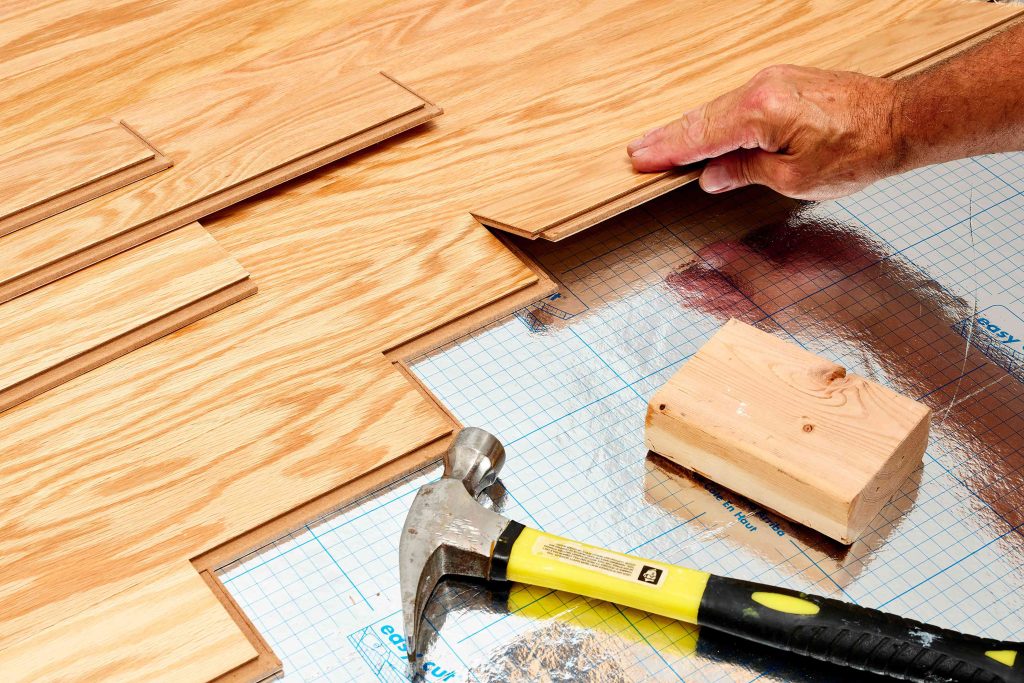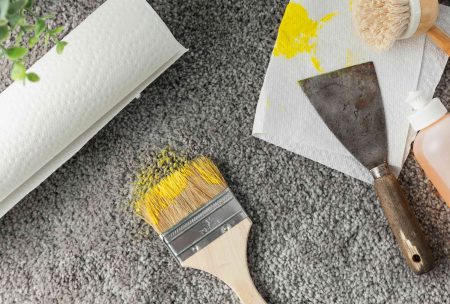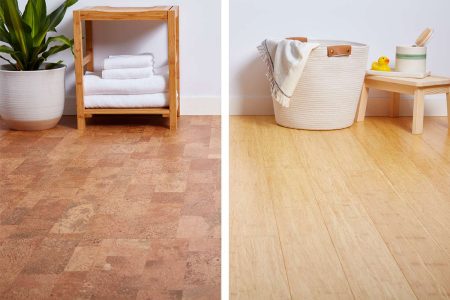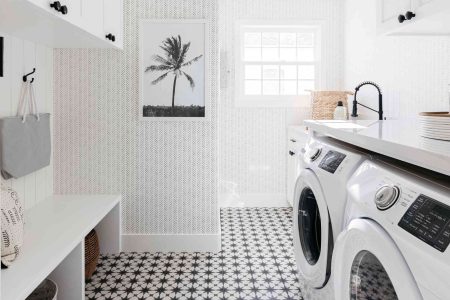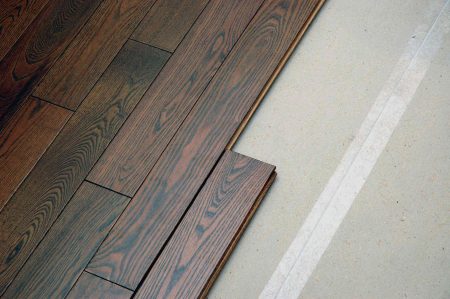Engineered wood flooring is a beautiful, durable flooring product that offers a few different installation options.
What Is Engineered Hardwood Flooring?
Engineered wood flooring looks very similar to hardwood flooring but it’s constructed differently. Engineered wood is made from a somewhat thin layer of hardwood bonded over a substrate of high-quality plywood. The cost to install engineered wood flooring is slightly less than hardwood flooring. (Hardwood can cost about $8 a square foot vs. engineered wood at around $4 to $7 a square foot.) But unlike refinishing hardwood flooring, engineered flooring only be sanded and refinished a couple of times due to the thin hardwood layer.
While some tongue-and-groove engineered flooring products are designed for glue-down application, as is often used when installing flooring over a concrete slab, this is typically a job for a contractor. The other two popular engineered wood floor installation methods are more DIY-friendly.
One involves nailing or stapling the floorboards, just like with traditional solid hardwood; this is called a nail-down installation. The other, called a floating floor, is by far the most popular with DIYers because it uses no glue or nails. Floating “click-lock” engineered hardwood flooring is easiest to install yourself. The following project instructs you on how to install engineered wood flooring over a plywood subfloor. You’ll have to also put the recommended underlayment under engineered hardwood. It’s not always recommended, but you may be able to lay thinner engineered wood over existing floorboards without having to remove them, but read the instructions or check with the manufacturer of the engineered flooring product you choose.
Engineered Wood Nail-Down vs. Floating-Floor Installation
Engineered wood flooring designed for nail-down (non-floating) installation has tongue-and-groove edges similar to traditional hardwood flooring. Most types can also be used for glue-down applications. A floating-floor installation follows a similar process to a nail-down floor but requires no nailing of the flooring planks.
With this installation method, the engineered wood planks are joined together with special interlocking joints, creating a single, continuous layer that “floats” over the subfloor.
Depending on the type of wood and thickness of the engineered wood flooring, either nails or staples can be used. It’s better to nail, not staple, thick and very hard types of engineered flooring. If you are installing engineered wood flooring with nails or staples, use the proper type of flooring stapler or nailer that is meant to handle the thickness of the flooring.
What You’ll Need
Equipment / Tools
- Pry bar
- Hammer
- Drill (as needed)
- Flush-cutting saw or oscillating tool
- Chalk line
- Flooring nailer or stapler
- Wood block
- Vacuum and hard flooring attachment
Materials
- Engineered wood flooring
- Flooring underlayment
- Finish nails
Instructions
How To Install Engineered Hardwood Floors
-
Acclimate the Boards
Unpack and lay out the flooring boards in the room where they will be installed to acclimate them to the temperature and humidity of the room. Follow the manufacturer’s recommendations for acclimation time. Do not store engineered wood flooring in basements or garages.
-
Remove the Base Trim
Remove the shoe molding (the small rounded molding in front of the baseboard) from around the room, using a pry bar. Also remove the baseboards, if desired; this is typically optional.
-
Remove the Old Flooring (as Needed)
Remove the old flooring, if necessary. Carpet and ceramic tiles floors will likely need to be removed, but a new engineered wood floor can often be installed directly over some types of vinyl flooring.
-
Prep the Subfloor
Clean, level, and prepare the subfloor by nailing or screwing down loose areas and checking for dips and other imperfections. The smoother and flatter your floor, the better your new installation will be.
-
Trim the Door Moldings
Trim door casing moldings at the bottom, so the new flooring can slide under. Special flush-cutting handsaws are available for this. An electric oscillating tool with a flush-cutting blade can also do this job easily.
-
Lay Down Underlayment
Install the recommended underlayment for nail-down or floating floor installations, as applicable. Standard underlayment for nail-down is builder’s paper, rosin paper, or felt. Floating-floors typically require a foam underlayment that adds some cushion and helps dampen sound.
-
Prepare for the First Row
Get ready for the first row of flooring boards:
For nail-down floors: Snap a chalk line that represents the leading edge of the first row of boards. Allow for the recommended expansion gap between the wall and the trailing (outside) edges of the boards.
For floating floors: Place wood or plastic spacer blocks along the wall where you will start. Each manufacturer will have a recommendation on how much space to allow, but 1/4 to 3/8 inches is typical.
-
Install the First Row
Begin installing a row of flooring strips along one long wall:
For nail-down floors: Position the boards with their tongue edges facing out and aligned with the chalk line. Fasten the boards with finish nails driven through the top face of the flooring (called face-nailing).
For floating floors: Set the first row of boards in place along the staring wall, with the tongue edges facing the wall and butted up against the spacers. End joints on this first row of planks will likely have interlocking joints. Secure them tightly, using a wood block and hammer.
-
Install the Subsequent Rows
Lay out the second and subsequent rows so the joints between boards are offset, or “staggered,” from one row to the next, for a natural appearance. Trim and fit flooring pieces as necessary around floor obstructions.
For nail-down floors: Set each new board so its groove fits over the tongues of the boards in the preceding row. Use a flooring nailer or stapler to fasten the boards through the tongue edges (a process called blind-nailing because the nails or staples are hidden by the next row of boards).
For floating floors: Install the planks for subsequent rows by holding each plank at an angle and fitting the tongue of the new board into the groove of the board(s) in the previously installed row, then press the new board flat to interlock the pieces. Tap the boards together, as needed, to tighten the joints, using a hammer and a wood block.
-
Reinstall the Base Trim
Reinstall (or replace) the baseboard trim (as applicable) and the shoe molding, and give the floor a thorough cleaning with a vacuum and hard-flooring attachment.
-
How long before you can put furniture on new engineered hardwood floors?
Depending on the product you choose, you may need to wait one to three days before putting your furniture on your new engineered flooring to allow for further acclimation. But always check the instructions on the packaging materials.
-
Should there be gaps in new engineered hardwood floor?
Newly installed engineered hardwood flooring should not have gaps, though gapping does occur due to various reasons, such as humidity or boards poorly fitted during a glue-down installation. That’s why it’s especially important to leave glue-down installations to expert installers. Gaps can be avoided during other types of installations with properly fitting boards.
-
Can you walk on newly installed engineered hardwood floors?
Wait a day after installation to walk on newly installed engineered hardwood flooring (and possibly even longer for furniture placement). But check the instructions on your product’s packaging.
Read the full article here



